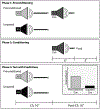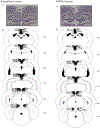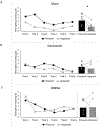Retrosplenial cortex damage impairs unimodal sensory preconditioning
- PMID: 32150422
- PMCID: PMC7244381
- DOI: 10.1037/bne0000365
Retrosplenial cortex damage impairs unimodal sensory preconditioning
Abstract
The retrosplenial cortex (RSC) is positioned at the interface between cortical sensory regions and the structures that compose the medial temporal lobe memory system. It has recently been suggested that 1 functional role of the RSC involves the formation of associations between cues in the environment (stimulus-stimulus [S-S] learning; Bucci & Robinson, 2014). This suggestion is based, in part, on the finding that lesions or temporary inactivation of the RSC impair sensory preconditioning. However, all prior studies examining the role of the RSC in sensory preconditioning have used cues from multiple modalities (both visual and auditory stimuli). The purpose of the present experiment was to determine whether the RSC contributes to unimodal sensory preconditioning. In the present study we found that both electrolytic and neurotoxic lesions of the RSC impaired sensory preconditioning with auditory cues. Together with previous experiments, these findings indicate that the RSC contributes to both multisensory and unimodal sensory integration, which suggests a general role for the RSC in linking sensory cues in the environment. (PsycInfo Database Record (c) 2020 APA, all rights reserved).
Figures





References
-
- Alexander AS, and Nitz DA (2015). Retrosplenial cortex maps the conjunction of internal and external spaces. Nat. Neurosci 18, 1143–1151 - PubMed
-
- Blaisdell AP (2009). The role of associative processes in spatial, temporal, and causal cognition In Rational Animals, Irrational Animals, Watanabe S, Blaisdell AP, Huber L, and Young A, eds. (Keio University Press; ), pp. 153–172.
-
- Brogden WJ (1939). Sensory preconditioning of human subjects. J. Exp. Psychol 25, 323–332. - PubMed

